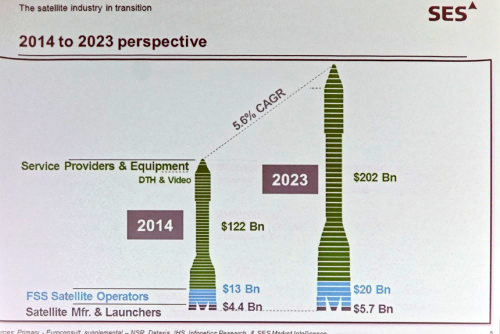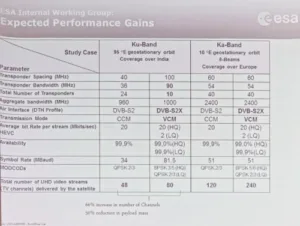 Daniel Biedermann is SVP of corporate development at SES and he started by saying that there are a lot of national satellite initiatives for making satellites, partly attracted by Chinese money and interest, so growth has been negative for satellite makers. Satellite operators have seen some growth (around 5.5% per year) and is expected to go from $13 billion to $20 billion. Meanwhile DTH and video operators could grown from $122 billion in 2014 to $202 billion in 2023. (See graphic below.)
Daniel Biedermann is SVP of corporate development at SES and he started by saying that there are a lot of national satellite initiatives for making satellites, partly attracted by Chinese money and interest, so growth has been negative for satellite makers. Satellite operators have seen some growth (around 5.5% per year) and is expected to go from $13 billion to $20 billion. Meanwhile DTH and video operators could grown from $122 billion in 2014 to $202 billion in 2023. (See graphic below.)
New devices are everywhere and need to be connected all the time. There are lots of new delivery technologies including LTE, white space, 5G etc as well as innovations in satellite. There is an increase in the complexity of ecosystems for content provision and there are new competitors.
However, 88% of internet traffic will be video by 2018 and the market for media and entertainment will be $2,200 billion and there will be 10,000 HD/UltraHD satellite channels by 2025 and 5,500 new satellite channels by 2023
The satellite back-haul market alone will be $5.3 billion by 2024 and in-flight ecosystems are expected to increase by 30X by 2025.
However, despite all the developments in infrastructure there will be more than four billion people offline in 2018 and as a result of the desire to connect them, the market will see growth of around 5%-6% over the period to 2023.
Going forward, in the video segment the key is to grow reach, improve quality and work out how to monetize online content. In data, the aim is to integrate with cloud architectures. In mobile, connectivity has to be genuinely global for planes, ships and trains. Government networking has its own special requirements.
 SES expects growth in satellite
SES expects growth in satellite
SES has been investing and has seven new satellites under procurement, with 70% going to developing regions. They will also support data, mobile and government.
Biedermann then went into satellite technology in some detail. Space tugs are coming that will allow old satellites to be captured, brought back to earth and serviced. Ariane 6 is a new rocket under development that will allow Europe to remain competitive in launch platforms. SpaceX is trying to reduce the cost of launch with re-usable rockets and Biedermann believes that although there have been some problems, they will succeed.
No single solution will be right for all applications which means that SES will need partners to succeed.
The next presentation was about improving satellite technology and one feature that is being developed that has demonstrated that it can run streams for STBs that can support multi-layer signals, where a base signal is sent along with a separate band that allows more resolution. This avoids the need for the broadcaster to send two full streams to support multi-resolution feeds. By dropping back to 99% availability for the UHD stream, for example, from 99.9% (the .9% would mean the possible use of the lower quality signal) the number of channels could be increased from 48 to 80 – a 66% increase. With new technologies, such as Ka band, the boost could be double.Channel boost is possible by allowing switching between UltraHD and HD
EISA is working on channel bonding to allow “left over” capacity from transponders to add extra channels.

